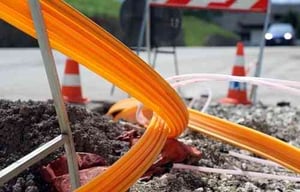3 Challenges of Fiber Deployment and How to Improve the Process
 Consumers are eagerly awaiting the next step in broadband technology: 5G. With an explosion of small cell and fiber deployment, internet is the fastest it’s been to date. Users can download and stream data better than ever before. We’ve been promised a new reality: self-driving cars, virtual reality, delivery drones, and comprehensive home automation.
Consumers are eagerly awaiting the next step in broadband technology: 5G. With an explosion of small cell and fiber deployment, internet is the fastest it’s been to date. Users can download and stream data better than ever before. We’ve been promised a new reality: self-driving cars, virtual reality, delivery drones, and comprehensive home automation.
The Internet of Things is creating a new tech landscape for the world, and its backbone is fiber. Broadband providers are scurrying to lay fiber optic cable as quickly as possible. Small cell and DAS are being deployed rapidly to boost signals in metro areas, at large event venues and in other challenging environments, often with fiber backhaul.
3 Reasons Deployment Isn’t Further Along
1. Distance
2. Cost
According to U.S. Department of Transportation data, the average cost of deploying fiber broadband is $27,000 per mile, which means some places cost a lot more than that. An economic consulting firm recently predicted it would cost $61 billion to deploy fiber broadband in all of the country’s unserved rural areas.
3. Installation Barriers
Actions Being Taken to Speed Deployment
Industry Support
Government Subsidies
Last year, the Federal Communications Commission committed to provide $2 billion in subsidies over the next decade to help extend broadband to unserved rural areas, where about 35 percent of residents have no broadband at all.Organizational Support
Many groups in the United States are conducting campaigns and advocacy platforms, urging the government to act faster, especially for American education and school systems.Policies
With the Dig Once Policy, infrastructure is installed and providers have adequate access to the ROW during roadway work. It lowers deployment expense by sharing costs of digging between road construction companies and broadband companies. Several states are opting into the policy, including Arizona, Minnesota, and Utah.
Municipal Fiber Networks
Public-Private Partnerships
Agreements between public entities and private companies, like major employers and large real estate developers, have become a common source of new FTTH and Fiber to the Building (FTTB) projects. Developers have realized that fast internet is an attractive incentive to offer potential subdivision and apartment residents, as well as small business tenants. Improvements in fiber flexibility have also made it easier to install in existing apartment buildings. On the other hand, community and business leaders are becoming aware that failure to ensure fast internet service is a good way to get left behind.Cooperative Action
How to Improve Fiber Deployment Internally
However, because of the many actions being taken to speed deployment and provide internet for all Americans, the joint use community is being impacted. As the nation changes, joint use departments should prepare for a high-volume of attachment requests, permitting paperwork, insurance requirement paperwork, billing and invoicing, OTMR documents, and much more.
Joint use owners are scurrying to ensure that their asset data is current and accurate. Several asset owners and attaching companies are exploring new, intuitive ways to prepare their departments for upcoming deployments. Spreadsheets and the use of multiple systems are being left behind. Joint use departments across the nation are switching to a system that works for their data and business processes.
Many companies are using a joint use platform that provides communication between external partners and internal departments. In fact, 39 states across the US are currently using the platform. The platform assists in managing new and existing asset data with workflows, dashboards, and mapping features.
If you would like assistance managing fiber deployment or if you would like more information on a joint use platform, contact Alden to speak with a product management specialist. We are happy to provide a consultation to discuss how a joint use management system may help your company.
How is your company managing fiber deployment? What preparations do you have in place to ensure clarity over your assets in the future? Let’s create a conversation about current joint use management trends in the comments below.

